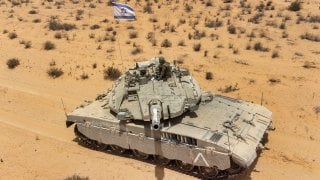Merkava: The Tank from Israel No Army Wants to Fight
Israel's Merkava main battle tanks demonstrated their capabilities when a Hezbollah strike was intercepted by the Trophy active protection system. The Merkava, a critical component of the Israeli Armored Corps, is highly regarded alongside the U.S. Abrams and Britain's Challenger 2.
Summary and Key Points: Israel's Merkava main battle tanks demonstrated their capabilities when a Hezbollah strike was intercepted by the Trophy active protection system. The Merkava, a critical component of the Israeli Armored Corps, is highly regarded alongside the U.S. Abrams and Britain's Challenger 2.

-Developed post-1973 Yom Kippur War to protect its crew, the tank features thick armor, a unique engine layout, and powerful armaments, including a 120 mm main gun.
-The latest fifth-generation "Barak" variant enhances intelligence and situational awareness with advanced sensors and a 360-degree Elbit helmet. The Merkava remains a cornerstone of Israel's defense strategy.
Israel’s Merkava Tank Profile
The Israeli military’s Merkava main battle tanks again proved their worth after a recent Hezbollah strike.
The Iran-backed terror group claimed one of its Almas missiles struck an Israeli Merkava earlier this month. But analysis of a video shared by Hezbollah suggests the tank was able to employ its Trophy active protection system to detect and intercept the incoming projectile.
The Merkava is the backbone of the Israeli Armored Corps and is widely considered as capable as more well-known Western MBTs including the U.S. Abrams and Britain’s Challenger 2. The Merkava platform is instrumental to Israel’s defensive strategy.
An Overview of the Merkava
During Israel’s early days as an independent nation after World War II, it quickly realized its need for protection against hostile neighbors. Until the 1960s, the Jewish state largely relied on joint projects and weapons deliveries from other nations. The IDF collaborated with the British to develop a Chieftain MBT variant, but the UK nixed this program since Chieftain tanks were already being supplied to Arab countries. Former IDF General Israel Tal then kickstarted plans to develop a completely homegrown MBT.
In the 1973 Yom Kippur War, Israel’s armored corps suffered greatly during coordinated attacks launched by Egypt and Syria in the Sinai Peninsula and Golan Heights. Their enemies were equipped with some of the latest Soviet-designed tank variants of the time, and Israel’s own arsenal of less advanced MBTs could not keep up. For this reason, the Merkava tank would be built first and foremost to limit casualties.
Specs & Capabilities
In order to better protect its crew members, the Merkava was built with thick armor. The layout of the engine transmission was reversed in order to provide an extra level of protection for soldiers. This unique positioning also increased storage capacity and access for the tank’s operators.
In terms of armaments, the Merkava has always packed a punch. The latest variant sports an IMI 120 mm L44 main gun, a 7.62 mm light machine gun, and an M2 Browning .50-caliber heavy machine gun. The tank’s main gun can also fire armor-piercing and high-explosive shells.
The Trophy active protection system might be the tank’s best attribute. This homegrown system protects the MBT from anti-tank rockets, high-explosive anti-tank rounds, anti-tank guided missiles, and other projectiles. It also increases the crew’s survivability by enhancing the MBT’s capacity to detect enemy tanks.
Introducing the “Barak” Merkava Variant
Last year, the IDF and Israel’s Defense Ministry revealed the fifth-generation “Barak” Merkava MBT after years of development.
The Ministry detailed that the tanks are equipped with a “wide infrastructure of reliable sensors” that enabled better intelligence information: “The Barak tank will strengthen the capabilities of detecting enemies and will enable fighting against an enemy with a reduced signature and in all combat scenarios, on the current and future battlefield, against the entirety of threats that exist for the maneuvering force,” the Ministry added. The Barak variant will also provide a 360-degree Elbit helmet, which will provide the crew commander with a full view of their surroundings.

Considering the Merkava’s popularity, it is unlikely that the Israeli military will give up on its tried and tested tank series in the near future.
About the Author: Maya Carlin
Maya Carlin, National Security Writer with The National Interest, is an analyst with the Center for Security Policy and a former Anna Sobol Levy Fellow at IDC Herzliya in Israel. She has by-lines in many publications, including The National Interest, Jerusalem Post, and Times of Israel. You can follow her on Twitter: @MayaCarlin.
All images are Creative Commons and/or Shutterstock.


